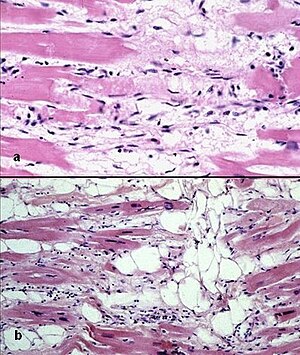Arrhythmogenic right ventricular dysplasia
| Arrhythmogenic right ventricular dysplasia | |
|---|---|
| Synonyms | arrhythmogenic right ventricular cardiomyopathy (ARVC), arrhythmogenic right ventricular dysplasia/cardiomyopathy (ARVD/C), right ventricular dysplasia |
 |
|
| Photomicrograph of an ARVC heart. | |
| Classification and external resources | |
| Specialty | cardiology |
| ICD-10 | I42.8 |
| OMIM | 107970 |
| DiseasesDB | 29750 |
| Patient UK | Arrhythmogenic right ventricular dysplasia |
| MeSH | D019571 |
Arrhythmogenic right ventricular dysplasia (ARVD) is an inherited heart disease.
ARVD is caused by genetic defects of the parts of heart muscle (also called myocardium or cardiac muscle) known as desmosomes, areas on the surface of heart muscle cells which link the cells together. The desmosomes are composed of several proteins, and many of those proteins can have harmful mutations.
The disease is a type of nonischemic cardiomyopathy that involves primarily the right ventricle. It is characterized by hypokinetic areas involving the free wall of the right ventricle, with fibrofatty replacement of the right ventricular myocardium, with associated arrhythmias originating in the right ventricle.
ARVD can be found in association with diffuse palmoplantar keratoderma, and woolly hair, in an autosomal recessive condition called Naxos disease, because this genetic abnormality can also affect the integrity of the superficial layers of the skin most exposed to pressure stress.
ARVC/D is an important cause of ventricular arrhythmias in children and young adults. It is seen predominantly in males, and 30–50% of cases have a familial distribution.
Up to 80% of individuals with ARVD present have symptoms like syncope and dyspnea.The remainder frequently present with palpitations or other symptoms due to right ventricular outflow tract (RVOT) tachycardia (a type of monomorphic ventricular tachycardia).
Symptoms are usually exercise-related. In populations where hypertrophic cardiomyopathy is screened out prior to involvement in competitive athletics, it is a common cause of sudden cardiac death.
...
Wikipedia
